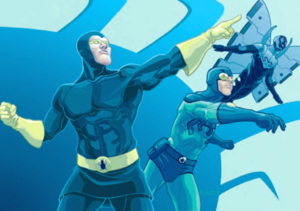
Blue Beetle is the name of three fictional superheroes who appear in a number of American comic books published by a variety of companies since 1939. The most recent of the companies to own rights to the Blue Beetle is DC Comics who bought the rights to the character in 1983, using the name for three distinct characters over the years.

The Peacemaker is the name of a series of superheroes originally owned by Charlton Comics and later acquired by DC Comics. The original Peacemaker first appeared in Fightin' 5 #40 and was created by writer Joe Gill and artist Pat Boyette.

Flash Comics was a comics anthology published by All-American Publications and later by National Periodical Publications. The title had 104 issues published from January 1940 to February 1949. Despite the title, the anthology featured the adventures of multiple superheroes in addition to Jay Garrick, the original Flash. Characters introduced in the series include the Flash, Hawkman, and Black Canary.

Dark Circle Comics is an imprint of Archie Comics Publications, Inc. Under its previous name, Red Circle Comics, it published non-humor characters, particularly superheroes in the 1970s and 1980s, and was a digital imprint from 2012 to 2014. In 2015, it was converted back to a print imprint and was completely revamped as Dark Circle Comics, featuring darker and more mature content than previous incarnations of Archie's superhero line.

Boy Commandos is a fictional organization from DC Comics first appearing in Detective Comics #64 by Joe Simon and Jack Kirby. A combination of "kid gang" characters, an international cast of young boys fighting Nazis — or in their own parlance, "the Ratzies".
"Charles Nicholas" is the pseudonymous house name of three early creators of American comic books for the Fox Feature Syndicate and Fox Comics: Chuck Cuidera (1915–2001), Jack Kirby (1917–1994), and Charles Wojtkoski (1921–1985). The name originated at Eisner & Iger, one of the first comic-book "packagers" that created comics on demand for publishers entering the new medium during the 1930s–1940s Golden Age of comic books. The three creators are listed in order of birth year, below.
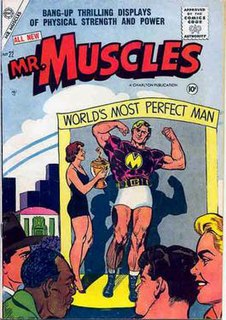
Mr. Muscles is a fictional comic book superhero created in 1956 by writer Jerry Siegel for Charlton Comics, and drawn by Bill Fraccio for the first of two issues of his namesake comic, and by the team of penciler Charles Nicholas and inker Vince Alascia for the second. A young Dick Giordano provided the premiere issue's cover.

Comic Cavalcade was an anthology comic book published by DC Comics from 1942 to 1954.

Theodore Stephen "Ted" Kord is the second Blue Beetle, an occasionally dead superhero who was originally published by Charlton Comics and later picked up by DC Comics. This version of the character was created by Steve Ditko and first appeared as a back-up feature in Captain Atom #83, with Gary Friedrich scripting from Ditko's conception and plot.
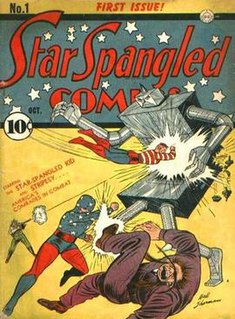
Star Spangled Comics was a comics anthology published by DC Comics which ran for 130 issues from October 1941 to July 1952. It was then retitled Star Spangled War Stories and lasted until issue #204.

Crestwood Publications, also known as Feature Publications, was a magazine publisher that also published comic books from the 1940s through the 1960s. Its title Prize Comics contained what is considered the first ongoing horror comic-book feature, Dick Briefer's "Frankenstein". Crestwood is best known for its Prize Group imprint, published in the late 1940s to mid-1950s through packagers Joe Simon and Jack Kirby, who created such historically prominent titles as the horror comic Black Magic, the creator-owned superhero satire Fighting American, and the first romance comic title, Young Romance.
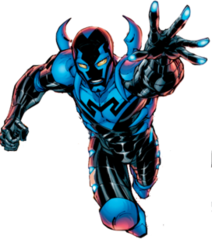
Jaime Reyes is a fictional superhero appearing in American comic books published by DC Comics. Created by Keith Giffen, John Rogers, and Cully Hamner, the character made his first appearance in Infinite Crisis #3.
The Holyoke Publishing Company was an American magazine and comic-book publisher with offices in Holyoke, and Springfield, Massachusetts, and New York City, Its best-known comics characters were Blue Beetle and the superhero duo Cat-Man and Kitten, all inherited from defunct former clients of Holyoke's printing business.
The Scarab is a fictional superhero from the Golden Age of Comics. He first appeared in Startling Comics #34, published by Nedor Comics. The character was later revived by writer Alan Moore for America's Best Comics.

Blue Bolt is a fictional American comic book superhero created by writer-artist Joe Simon in 1940, during the period fans and historians refer to as the Golden Age of Comic Books.
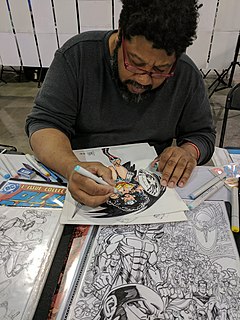
Paris Cullins is an American comics artist best known for his work on DC Comics' Blue Devil and Blue Beetle and Marvel Comics' Hyperkind.
Novelty Press was an American Golden Age comic-book publisher that operated from 1940–1949. It was the comic book imprint of Curtis Publishing Company, publisher of The Saturday Evening Post. Among Novelty's best-known and longest-running titles were Blue Bolt and Target Comics.

National Comics Publications, the precursor to DC Comics, began publishing superhero comics titles in the 1930s. Comic book anthology titles created by the company included were More Fun Comics, Adventure Comics, Detective Comics and Action Comics. Other companies like Quality Comics, Fawcett Comics and All-American Comics that were later absorbed into DC also debuted in the same decade. During the period, National launched popular superhero characters like Superman, Batman and Sandman.

























